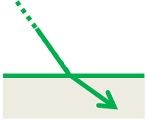 The two phenomena based on straight light propagation are reflection and refraction, wherein the reflection deals with the bouncing of light rays whereas the refraction talks about bending of light rays.
The two phenomena based on straight light propagation are reflection and refraction, wherein the reflection deals with the bouncing of light rays whereas the refraction talks about bending of light rays.
Our world is full of objects that we can see only with the help of light. If there is the absence of light in a room, nothing is visible to us. Have you ever wondered, how can we perceive things with eyes? In the daytime, it is the light rays coming from the sun, that help us to see objects, i.e. as the light rays fall on it, the object reflects light, which when received by our eyes, the object becomes visible. Likewise, there is a diverse range of phenomena concerning light that can be explored with the help of a thorough study.
So, take a look at the article to know the difference between reflection and refraction
Content: Reflection Vs Refraction
Comparison Chart
Definition of Reflection
In simple terms, reflection implies the rebounding of light, sound, heat or another object back to the source, without absorbing it. It alters the direction of the beam of light, when it falls on the plane, amidst two media, so that the ray goes back to the medium, in which it is generated. The law of reflection says:
- The angle of incidence is identical to the angle of reflection.
- The ray of incidence, ray of reflection and the normal drawn at the point of incidence, to the mirror, occurs at the same plane.
These two principles are apposite to all kinds of reflecting planes. Reflection can be of two types:
- Regular reflection: Otherwise known as specular reflection, which occurs when the beam of light falls on a regular, polished and smooth plane, such as metal or mirror, reflects light at the same angle as it is incident to the surface.
- Irregular reflection: Also called as diffused reflection, which takes place when the beam of light is incident on the rough surface and reflects light in diverse directions
Definition of Refraction
Refraction can be understood as the phenomenon of light, wherein the wave is diverted when it passes diagonally through the interface between two media of different densities. It refers to the shift in direction and speed of the beam of light or radio waves, because of the change in transmission medium
Refractive index is the ratio of the angle of incidence to the angle of refraction. It ascertains the speed of a ray of light in the new medium, i.e. the denser the medium the slow is the speed of light, and vice versa. Hence, the degree of bending vests on the refractive index of the two media.
Key Differences Between Reflection and Refraction
The points presented below are substantial, so far as the difference between reflection and refraction is concerned:
- The reverting of light or sound waves in the same medium, when it falls on the plane, is called reflection. The shift in the direction of the radio waves, when it enters medium with different density, is known as refraction.
- In reflection, light ray falling on the plane returns to the same medium. Conversely, in refraction, the ray falling on the plane travels from one medium to another.
- In reflection, the waves bounce off the surface. On the contrary, in refraction, the waves pass through the surface, that changes their speed and direction.
- In reflection, the angle of incidence is same as the angle of reflection. As against this, the angle of incidence is not similar to the angle of refraction.
- Reflection takes place in mirrors, while refraction occurs in lenses.
Conclusion
All in all, reflection and refraction are two basic facts associated with light, which are studied along. Reflection is when the light goes back to the previous medium, but changes direction. On the flip side, Refraction is when the light is absorbed by the medium, but the direction and speed are affected.








Shashank says
The differences was explained better
Thanks
Angela says
This was perfect for my assignment ✍️. Thanks!!🎀
Sweety says
This is super for 10 examination
Maitri Sharma says
I have exactly written the same answer in my exam and I got full marks on this.
Thanks and please provide some more questions